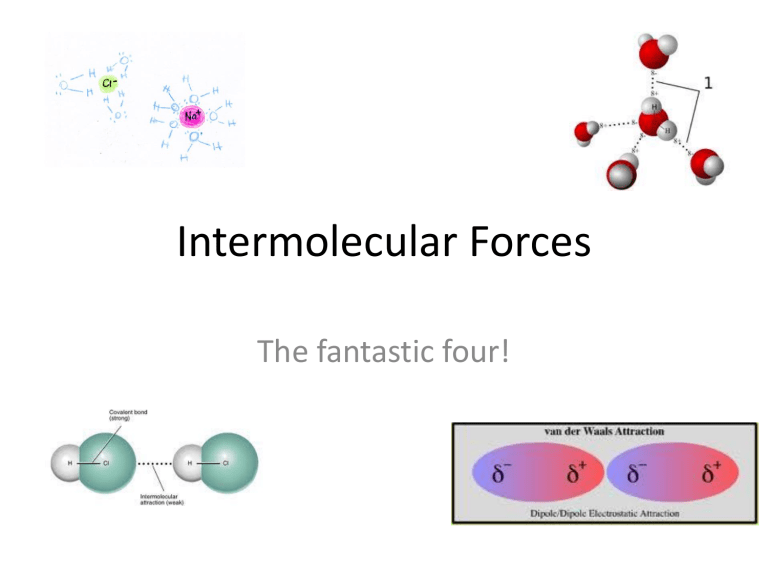
Intermolecular Forces The fantastic four! ION-DIPOLE FORCE Why does salt dissolve in water? Using the phrase “like dissolves like” means that salt (NaCl) must have something in common with water (H2O). They have like poles (as in charges, though not always full charges). The dissolving process is allowed by the development of intermolecular forces between the Na+ and water molecules. As the salt is dissolved by the water, it breaks into its anion (Cl-) and cation (Na+) http://www.youtube.com/watch?v=xdedxfhcpW o Forms between: An ion-dipole force requires ions (generally a soluble salt such as NaCl or CaCl2) and a polar solvent (like water or rubbing alcohol). DIPOLE-DIPOLE FORCE Why does rubbing alcohol dissolve in water? For these two substances to mix or for the rubbing alcohol (isopropyl alcohol) they must be alike. And they are due to existing partial charges! The force that allows these two molecules to interact is the dipole-dipole force. Forms between: A dipole-dipole force occurs between two substances which have unequal sharing of electrons which creates small partial charges. Partial negative Partial positive LONDON DISPERSION FORCE Why will oil and water not mix? Again, it’s the like dissolves like. Water has permanent dipoles, oil does not. Oil may have temporary poles that are induced by outside forces, but in general there is an even distribution of electrons. What will mix with oil? It needs to be another molecule which does not have dipoles or at least part of a larger molecule does not have dipoles. Acetone will dissolve in cooking oil. Why? Acetone does not have an overall polarity (poles). Forms between London dispersion forces are present in all interactions, but it is dominant in non-polar molecules because no other intermolecular force is present. It will have temporary (induced) poles. HYDROGEN BONDING Why will ice float in water? Oh, its hydrogen bonding and the fact that the water molecules (liquid) are actually closer together in the liquid then in the solid. In the solid, the hydrogen bonding is rigidly holding the molecules apart (not any extra kinetic energy to move them closer). And the Snow Flake? The shape of snow flakes are actually determined by the shape of water molecules and the intermolecular forces between them. Water molecules use hydrogen bonding to stick to each other (not to from the bonds inside the water molecule itself). Requirements to be present 1. It must have H in the molecule 2. It must have N, O or F present in the molecule Hydrogen Bonding Video http://www.youtube.com/watch?v=lkl5cbfqFRM Strongest to Weakest Strongest intermolecular force Ion-Dipole (full charges on the ions) Hydrogen Bonding Dipole-Dipole London Dispersion Forces (no permanent charges partial or complete) Impact of Strength of Intermolecular Forces The stronger the intermolecular force (within a series of like elements) the higher the melting and boiling points will be. So by looking at the boiling points for a series of molecules, the one with the highest value also has the strongest intermolecular forces. Impact of Strength of Intermolecular Forces London Dispersion Force For a pair of molecules which have London Dispersion Force, to determine which one has the strongest, you look at which one has the largest number of electrons. This is generally going to be the molecule which has the largest total mass. The more electrons, the more the electron cloud could be deformed.





